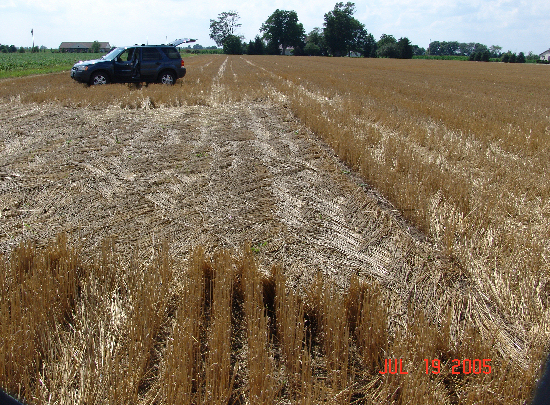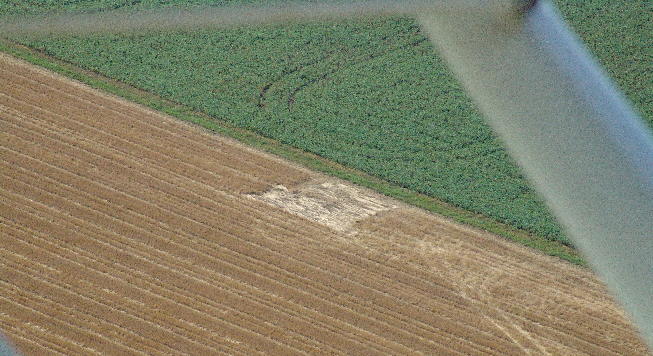|
| |


Interviews with Jerry Pippin
 
Photos of formation (next morning) and the source of the formation (a beam of
light, as described in the interview below).
 |
Nancy Talbot, Director of
BLT Research, 8/23/02, Part 1. Nancy is a leading and internationally respected
crop circles researcher. In this excerpt from her two hour interview on the
Jerry Pippin Show, Nancy tells of her on personal close encounter
experiences prior to and during the formation of a crop circle. And, in
Part
2, hear Nancy's theories on the origins of crop circles. |

News from Nancy
 |
|
-- PRESS RELEASE –
DATE: July 24, 2005
RE: Herringbone "Weave" Found in Greene County, Ohio
Crop Formation
[photos: BLT Research Team Inc.]
On July 5, 2005 a Greene
County farmer found what may be the very first crop formation of its kind
in the world. The farmer, who wishes to remain anonymous, discovered an
approximately 44' x 35' rectangle of downed wheat as he was harvesting his
field, at first thinking the downed-crop area had been caused by deer.
Upon closer examination he realized there was a distinct design to the
manner in which the plants were bent over, resulting in a "woven" or
interlaced herringbone pattern throughout the flattened crop.
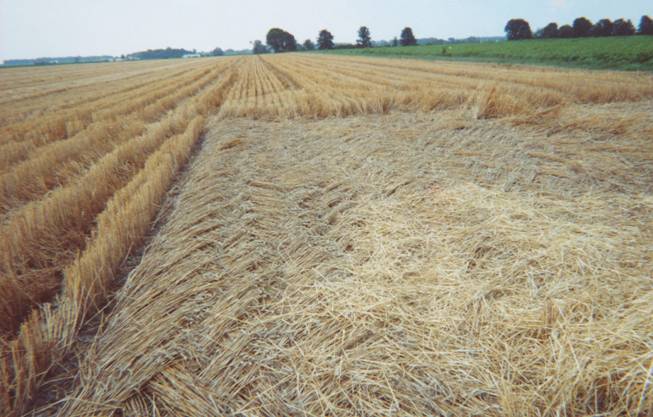 |
|
Photo taken by farmer on July 5th
showing one straight edge of formation & beginning of
herringbone pattern; cut chaff (on
right) lies on top of the flattened crop.
|
|
|
Photo taken by
BLT fieldworker JoAnne Scarpellini on July 19th, looking East;
section on left is where combine cut
part of the formation on July 5th.
|
The farmer reports that the 4 rows of wheat
along the Southern edge of the field were not affected and that he saw no
footprints or tracks in the flattened areas or along the grassy edge of
the field. From the air the peculiar squarish overall design does not
suggest a typical crop circle, and the herringbone lay of the plants is
not apparent. The farmer had begun cutting along the Southern edge
(closest to the green soybean field) of the wheat field and then swung
across the very irregular East edge of the formation, obscuring some of
the original detail there.
|
|
|
Aerial photo taken July 20th.
|
Examination on the ground by the farmer on
July 5th, and later on by BLT fieldworkers JoAnne Scarpellini and Nick
Reiter on July 19-20 & 23 showed that the intricate character of the lay
was intact, except where the combine had either cut some of the rows or
had blown chaff out over a part of the formation. The wheat had been
planted in a 7" drill (7" apart) and there were 60 rows of flattened
plants running E/W.
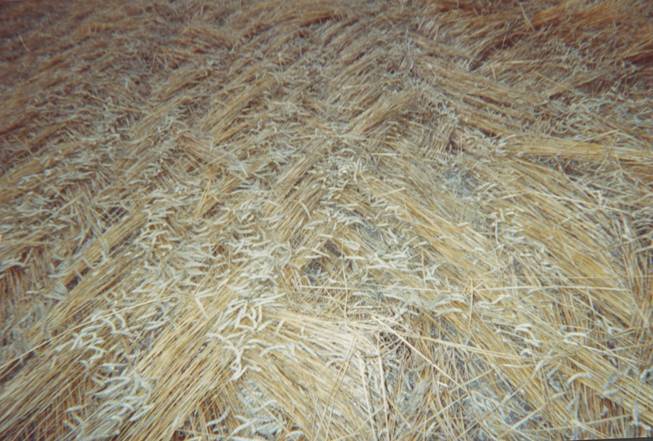 |
Close-up of herringbone lay pattern,
taken by farmer on July 5th.
|
| |
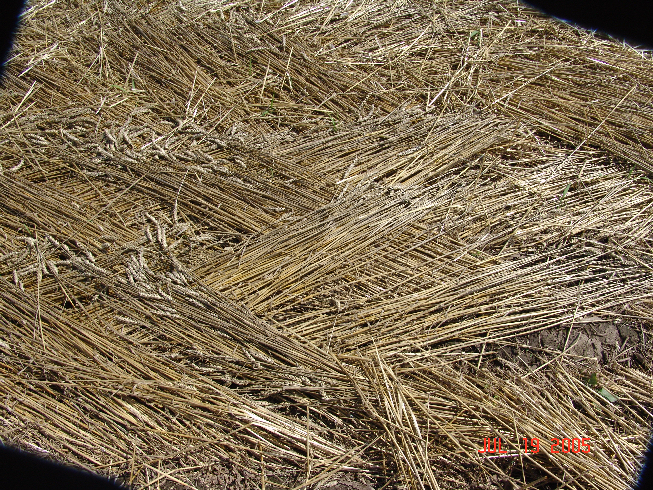 |
|
Close-up taken on July 19th which
suggests that the herringbone pattern has been
created more by an interlacing of
plants than an actual weave.
|
The
field examination revealed that a majority of the plants were bent over at
the base, with the stems unbroken. No expulsion cavities were found and
no visible node elongation was apparent. Although the farmer had cut the
rest of the field, some seeds were obtained from control areas as well as
seed-heads from within the formation so that germination studies can be
conducted. Geiger-counter checks revealed nothing anomalous and there
were no compass irregularities observed. Soil samples were taken to check
for magnetic particle content, as well as soils for chemical analyses and
a mycorrhizal fungi examination.
Close examination of each row
of flattened crop revealed that the first 4 rows were laid in one distinct
pattern, the next 4 rows in a different pattern, and that these two
complex pattern sets repeated across all 60 rows. A diagram showing these
lay details will be included in the final BLT Report.
A neighbor and his wife
report a strange lighted object in th sky on the same afternoon that the
formation was discovered—a cloud-like object which seemed to be
"flickering" in a manner similar to a fluorescent light—which boh husband
and wife took at first to be lightning, although there were no storm
clouds present and no thunder or rain. For 20 minutes or so they observed
multiple flashing incidents, with very intense colors appearing for 2-3
seconds, the colors becoming more and more intense as the incidents
continued. The husband, who works as a lineman for the local power
company, stated that there was no "blue color, as in a transformer going
off," but that the flashing looked more like an "ignition of some sort"
inside the cloud.
And the farmer reported that
he observed that his farm dog (which does not live in the house) had
suddenly exhibited very strange behavior, refusing to go outside as was
its custom, attempting instead to stay inside the family's garage as close
to the steps into the house as it could. This behavior began the day the
crop formation was discovered and continued for the following 2 weeks.
In the absence of several of
the scientifically documented plant changes which can be expected in crop
circles (elongated apical nodes, expulsion cavities) and since the soil
work will take time to complete--and given that this is the first time a
crop formation with squared edges and an interlacing herringbone pattern
in the crop has been observed--we are not certain if this is a crop circle
or not. The circles have, over the years, evolved from their original
state, and perhaps this Greene County, Ohio event is revealing a brand new
aspect of the ongoing phenomenon.
A written report will be
posted on the BLT web-site when the germination study and various soils
analyses are completed; perhaps then we will have a better idea of which
category best suits this event.
 |
|
 |
3/9/04: X-Ray Diffraction Study Of Clay Minerals In Crop
Circle Soils
From Nancy Talbott
bltresearch@comcast.net
After constant delays (mostly due to financial constraints) the X-ray
diffraction study of clay minerals in crop circle soils, which was begun in
1999 and completed in late 2001, is now available on the BLT Research Team
Inc.'s web-site at: http://www.bltresearch.com/xrd.html. BLT is most grateful to Mr. and
Mrs. Lyman D. Rogers of Newtown, Connecticut, whose financial support made
this possible, and to web-site personnel Kim McDonald Gazecki, William
Bombardier, and Abby Lewis who did the actual work of transferring the study
to the web.
This study, funded by Laurence Rockefeller, examined specific clay minerals
(those which are called "expandable" clays and which are most sensitive to
heat) in crop circle soils, in an attempt to gather further data which might
inform us regarding the hypothesized presence of microwave radiation at crop
circle sites. Multiple scientists were involved (see "Study Personnel"), most
of whom were totally unacquainted with the crop circle phenomenon at the time
they carried out their individual work on the project. These scientists were
carefully chosen, not only for their specific expertise, but because they were
unaware of the phenomenon, thus ruling out any potential assertions by
skeptics of "experimenter bias."
The results are startling. Specific clay minerals (illite/smectites) are
shown to exhibit a subtle, but statistically significant, increase in degree
of crystallization....a change heretofore seen only in sedimentary rock, which
has been exposed to the massive pressure (called "geologic" pressure) of tons
of overlying rock and to heat from the earth's core over hundreds, or
thousands of years. To our knowledge this increase in degree of
crystallization has never been reported previously in surface soils (as is the
case here).
If "geologic" pressure had been present, obviously the plants would have
been obliterated. And, of course, they were not. Further, if the intense heat
required (a minimum of 6-800 degrees C, over a period of many hours) to
produce the crystalline change (in the absence of such geologic pressure) had
been present, the plants would have been incinerated. And, again, they were
not. The plants did show the well-documented changes (elongated apical nodes,
presence of expulsion cavities) regularly found in crop circles which are not
created by mechanical flattening (i.e., with planks and boards). What is MOST
interesting is the fact that both the documented plant changes and the
increases in clay-mineral crystallization occurred at the SAME sampling
locations. A regression analysis found that the node-length increases in the
plants were correlated with the increase in crystallization of the clay
minerals in the soils at the 99.2% level of confidence, a truly extraordinary
result.
So the data appear to indicate that whatever caused the plant changes, also
caused the soil changes at the same sampling locations. And yet we realize
that the intense energy situation required to produce the soil effects would
have destroyed the plants altogether. As Dr. Reynolds, the Dartmouth
mineralogist and recognized authority on clay minerals and the XRD technique
whom we asked to review our study stated, we are apparently dealing with an
energy currently unknown to science.
As is often the case in science, new and intriguing questions have been
raised. The notion of mechanical flattening, however, is without question
ruled out. We hope that all interested members of the crop circle community
will take the time to examine the new study. All of the data and personnel
involved have been included on the web-site. BLT welcomes comments and/or
questions. Please note, also, that many other changes and additions have been
made to other pages on the site, including the following pages: "Home," "Plant
Abnormalities," "Clay-Mineral XRD Study," "Other Facts," "Professional
Consultants," "Lab Reports," and "Contact." |
 |
Additional information about Nancy's crop circle investigations and
research projects on our CROP CIRCLES
page.
|

 
| |
|




![]()
![]()

